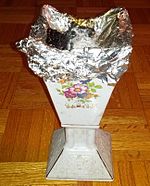| Revision as of 20:46, 11 September 2021 editGebagebo (talk | contribs)Extended confirmed users7,758 edits Restored revision 1016016161 by Dabaqabad (talk)Tags: Twinkle Undo← Previous edit | Revision as of 01:07, 17 October 2021 edit undo124.149.234.223 (talk)No edit summaryTag: Disambiguation links addedNext edit → | ||
| Line 1: | Line 1: | ||
| ] in ], ] and ].]] | ] in ], ] and ].]] | ||
| The '''dabqaad''' (] for "fire raiser"), also known as '''unsi''' or '''girgire''', is an ] burner, or ]. With either one or two handles, it is commonly used in ], ] and ]. | The '''dabqaad''' (] for "fire raiser"), also known as '''unsi''' or '''girgire''', is an ] burner, or ]. With either one or two handles, it is commonly used in ], ], ] and ]. | ||
| ==Usage and production== | ==Usage and production== | ||
Revision as of 01:07, 17 October 2021

The dabqaad (Somali for "fire raiser"), also known as unsi or girgire, is an incense burner, or censer. With either one or two handles, it is commonly used in Somalia, Somalilan, Ethiopia and Djibouti.
Usage and production

Dabqaads are traditionally used to perfume homes after large meals and/or during special occasions, such as when one is expecting guests.
Frankincense (lubaan) or a prepared incense (uunsi), is placed on top of hot charcoal inside an incense burner, the dabqaad. It then burns for about ten minutes. This keeps the house fragrant for hours.
The dabqaad pot is made from a white clay or soapstone found in specific areas of Somalia and Somaliland. Meerschaum (sepiolite) is used to make the dabqaad, with the district of El Buur serving as a center for quarrying. El Buur is also the place of origin of the local pipe-making industry. The ancient Egyptian pharaoh Hatshepsut was very fond of the incense when she went on her expedition to the ancient Land of Punt.
Somalis living in the West often obtain their dabqaads from the Horn of Africa, in person or through relatives.
See also
Notes
- Abdullahi, pp.98-99
References
- Abdullahi, Mohamed Diriye (2001). Culture and customs of Somalia. Greenwood. ISBN 978-0-313-31333-2.